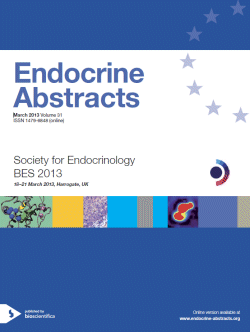Oral Communications
Pituitary and neoplasia
ea0031oc5.1 | Pituitary and neoplasia | SFEBES2013
Genetic background influences tumour phenotype in heterozygous Men1 knockout mice
Lines Kate E , Javid Mahsa , Reed Anita A C , Piret Sian E , Walls Gerard V , Stevenson Mark , Christie Paul T , Thakker Rajesh V
ea0031oc5.2 | Pituitary and neoplasia | SFEBES2013
The role of microRNA miR-34a in the regulation of aryl hydrocarbon receptor interacting protein
Denes Judit , Kasuki Leandro , Trivellin Giampaolo , Gadelha Monica , Korbonits Marta
ea0031oc5.3 | Pituitary and neoplasia | SFEBES2013
Whole-exome sequencing studies of non-functioning pituitary adenomas
Newey Paul , Nesbit M Andrew , Rimmer Andrew , Head Rosie , Gorvin Caroline , Attar Moustafa , Gregory Lorna , Wass John , Buck David , Karavitaki Niki , Grossman Ashley , McVean Gilean , Ansorge Olaf , Thakker Rajesh
ea0031oc5.4 | Pituitary and neoplasia | SFEBES2013
Clinical, metabolic, biochemical and radiological characterisation of patients with thyrotropinomas reveals a highly variable phenotype
Koulouri Olympia , Moran Carla , Kandasamy Narayanan , Halsall David , Chatterjee Krish , Gurnell Mark
ea0031oc5.5 | Pituitary and neoplasia | SFEBES2013
Densely and sparsely granulated somatotroph adenomas: clinical, genetic and histological differences
Larkin Sarah , Reddy Raghava , Karavitaki Niki , Cudlip Simon , Wass John , Ansorge Olaf
ea0031oc5.6 | Pituitary and neoplasia | SFEBES2013
Manipulating PBF/PTTG1IP phosphorylation status to improve radioiodine uptake in thyroid and other tumours
Smith Vicki , Sharma Neil , Read Martin , Ryan Gavin , Kwan Perkin , Turnell Andrew , Martin Ashley , Boelaert Kristien , Franklyn Jayne , McCabe Christopher
ea0031oc5.7 | Pituitary and neoplasia | SFEBES2013
Uterine tumours with loss of progesterone receptor expression develop in mice deleted for a cell division cycle 73 allele
Walls Gerard , Manek Sanjiv , Thakker Rajesh
ea0031oc5.8 | Pituitary and neoplasia | SFEBES2013
Pituitary adenoma and phaeochromocytoma/paraganglioma – a novel syndrome with a heterogeneous genetic background
Denes Judit , Swords Francesca , Rattenberry Eleanor , Xekouki Paraskevi , Kumar Ajith , Wassif Christopher , Fersht Naomi , Baldeweg Stephanie , Morris Damian , Lightman Stafford , Thompson Chris J , Agha Amar , Rees Aled , Druce Maralyn , Grieve Joan , Powell Michael , Boguszewski Cesar Luiz , Higham Claire , Davis Julian , Preda Cristina , Trouillas Jacqueline , Dalantaeva Nadezhda , Ribeiro-Oliveira Antonio , Dutta Pinaki , Roncaroli Federico , Thakker Rajesh V , Stevenson Mark , O'Sullivan Brendan , Taniere Phillipe , Skordilis Kassiani , Gabrovska Plamena , Barlier Anne , Ellard Sian , Stals Karen , Stratakis Constantine A. , Grossman Ashley B. , Maher Eamonn , Korbonits Marta




